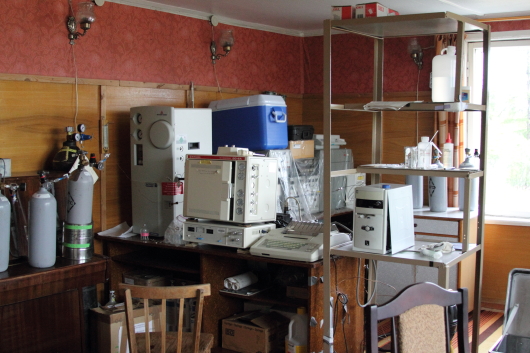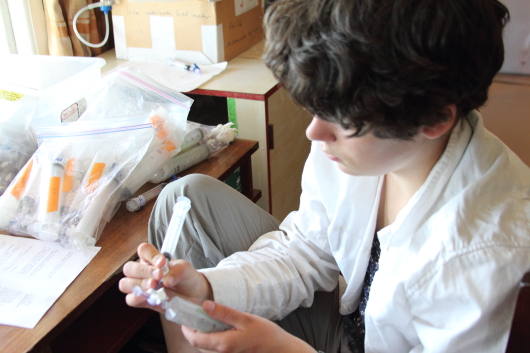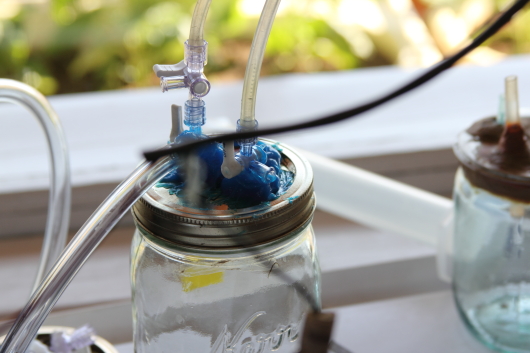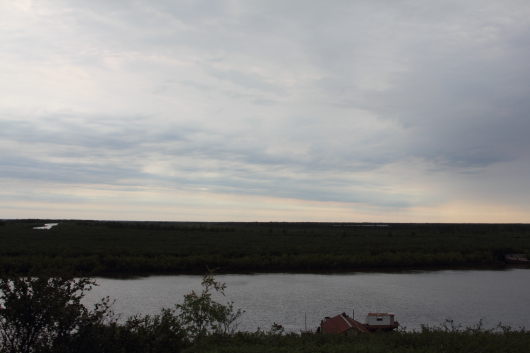Today we named three lakes and a stream. In the arctic research version of a naming ceremony (lacking red ribbons, giant scissors, and popping champagne), we had bug shirts, carboys, and a very special bucket (and an iPad). It was the usual style of life and work here. For instance, to begin tackling the question of the globally significant carbon flux in the Arctic, I string a well-taped and -tubed bucket around my arm to push, wrench, and hurl it through dense branches. The syringes of water I collect end up in a living room converted to lab, complete with giant batteries resting on an upright piano and portraits watching over the Victorianesque-furniture and gas chromatograph.

One of the rooms in the soil lab (aka the dry lab, the yellow lab, the winter lab…) is jam packed with analytical equipment amidst remnants of the building’s former life: a piano becomes a table for various tanks, a framed portrait still hangs on one wall and Victorian-esque wall sconces hang intermittently over the patterned wallpaper. © Becky Tachihara
In this lab, I analyze CO2 concentration using a Mason jar with at least three tubes going into the lid and even more valves. One tube connects to a pump – powered by a car battery – that pushes in atmospheric air. The other set feeds through a boxy machine that in mysterious ways presents a value for concentration of carbon dioxide. Nikita powers the contraption by appropriating a car battery using two aluminum wires (“What other lab would just have aluminum wire lying around?” –Nikita)
Max should never be allowed to name a lake again since he decided on Fledoma Lake, aping the congruence of flood plain and yedoma soils. Fledoma Lake (Nikita more logically called it Filipovka Lake for the river it feeds, while Anya nominated “Mr. Phil.”)

This gull was determined to protect its nest at Attack Lake. © Emily Sturdivant
Attack Stream. That was our “discovery” in the second boat excursion of the day. We wound through the curves of the Ambolikha River to a feeder stream and from there to a flood plain lake. As we emerged from the grassy banks (grassy from a boat, but slick and muddy on foot) we jerked up at a sharp screech to see an attacking gull intent on out motor boat as a threat to her nest and determined to exterminate us through either destroying our ear drums, pooping on us, or attempting to drag us out of the boat with her tiny gull’s feet. Far enough downstream of the lake, we settled at a stream and fittingly dubbed it Attack Stream. Only after the sample labels had dried did Max pull out his iPad to find an entirely different lake as the source, now known as Gull Lake (Gull and Attack Lakes must always be paired.).

Emily uses syringes to extract gas from a water sample in order to measure carbon dioxide concentrations. © Becky Tachihara
Since this is the Siberian Arctic, we are surrounded by unnamed lakes; lakes that may only last a few centuries or less before merging into a neighboring river or lake. They only become named when bottles must be labeled, GPS points correlated with meaningless words from the overly creative minds of scientists. The process must appear similar to naming our ubiquitous mosquito bites. Yet, in the middle of Attack Lake, I remembered my childhood dream to discover an island, and live somewhere never before visited by humans.

Various tubes curl into and around a mason jar rigged to a machine that will measure the concentration of carbon dioxide in a gas sample. © Becky Tachihara
There’s always new territory here, from the lakes, to the experiences, to the scientifically logical ways of quantifying interactions. Yet, even the novelty now feels familiar; I feel at home in the barge meal room/common room, now typing at 2 am, with the sky still light and mist blowing across the river – what causes that??? The tablecloth features many kinds of bread. What uncharted places will I go tomorrow?

Dusk light filters through a layer of wispy clouds creating the illusion of a sunset. © Becky Tachihara
Answer in addendum: Went down the Panteleikha to find Duckling Stream, Tern Lake, and Moose Beach (I saw my first arctic moose), all now labeled on the GPS. ALSO, it just hit me that all the terns swooping around Tern Lake migrated from Antarctica in the last few months. Incredible.




Comments(3)-
-
-
Jane Salerno says
July 22, 2011 at 2:34 pmHi Emily,
From my office at Clark, I’ve so enjoyed following and sharing news from the Polaris Project. Such a wonderful expedition!
Your blog post puts me in mind of a lullaby that was my own favorite as a child. Here’s how I recall the lyrics:
“I have a little sailboat and I’m going to sea;
I’ll follow all the seagulls ’til there’s no one there but me;
I’ll sail into the sun ’til I run out of blue
Then I’ll turn my sailboat and I’ll sail back to you.
I’m going to be a sailor, all the world I’ll explore;
Somewhere, there is an island no one’s ever found before
And when I find that island, all shiny and new
I’ll turn around my sailboat and I’ll sail back to
you.”
Enjoy the adventure!
Dorothy Wass says
July 26, 2011 at 2:48 amThat was quite lovely and very fitting with the description that Emily gave also. It sounds like a wonderful excursion,
margaret reynolds says
August 13, 2011 at 1:58 amWhat a beautiful journal entry! Your writing is exquisite. I felt I was right there with you discovering the islands and participating in their rather “elaborate” naming sans champagne brie and baguette!
Thanks for sharing your Siberian journey